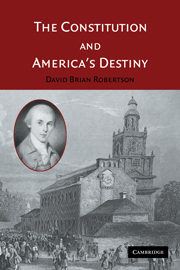Book contents
- Frontmatter
- Contents
- List of Tables and Figures
- Preface
- Acknowledgments
- List of Abbreviations
- 1 Politics and the Constitution
- 2 The Policy Crisis of the 1780s
- 3 James Madison's Plan for the Constitutional Convention
- 4 The Political Landscape of the Constitutional Convention
- 5 Who Governs? Constituting Policy Agency
- 6 What Can Be Governed? Constituting Policy Authority
- 7 How Is the Nation Governed? Constituting the Policy Process
- 8 Our Inheritance: The Constitution and American Politics
- Index
4 - The Political Landscape of the Constitutional Convention
Published online by Cambridge University Press: 11 November 2009
- Frontmatter
- Contents
- List of Tables and Figures
- Preface
- Acknowledgments
- List of Abbreviations
- 1 Politics and the Constitution
- 2 The Policy Crisis of the 1780s
- 3 James Madison's Plan for the Constitutional Convention
- 4 The Political Landscape of the Constitutional Convention
- 5 Who Governs? Constituting Policy Agency
- 6 What Can Be Governed? Constituting Policy Authority
- 7 How Is the Nation Governed? Constituting the Policy Process
- 8 Our Inheritance: The Constitution and American Politics
- Index
Summary
Like Madison, the other delegates came to the Constitutional Convention to change the course of American politics. Virginia's bold agenda forced them to confront the prospect of a strong national government and to consider many specific choices about national policy authority, policy agency, and the policy process. Republican principles provided little or no help in making these constitutional decisions. All the delegates embraced republican ideals, but these ideals alone could not resolve the fundamental dilemma the delegates faced: reconstituting the Confederation government so it could produce better policy outcomes, without harming the vital interests of their constituents. Political interests, not republican values, determined the delegates' approach to the specific problems of reconstituting American government.
Madison's plan to restructure America's political future directly challenged the nation's political present. Virginia's resolutions threatened the existing distribution of political power by redistributing basic tools of political management to the national government and increasing the agency of larger states in determining how these tools would be used. As representatives of existing polities, each delegate evaluated Madison's proposed changes in light of the present and future consequences for the welfare of his state and the nation.
As Madison expected, the delegations from the large and southern states initially lined up behind Virginia's plan. The plan's ambitious scope, however, helped unify delegates from states outside his coalition and provided opportunities to delay fundamental choices and chip away at key provisions.
- Type
- Chapter
- Information
- The Constitution and America's Destiny , pp. 100 - 130Publisher: Cambridge University PressPrint publication year: 2005



